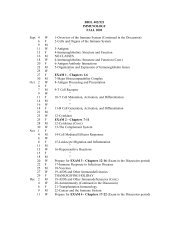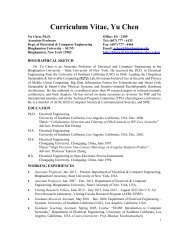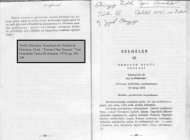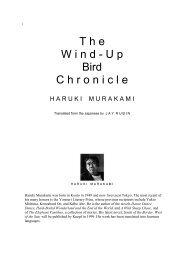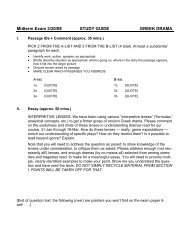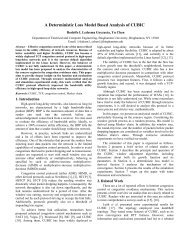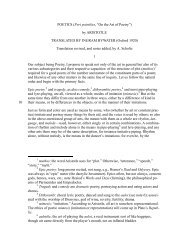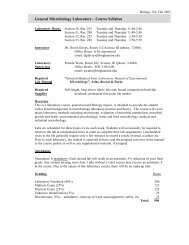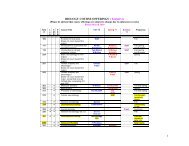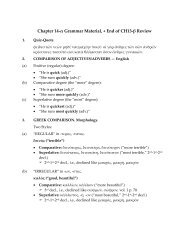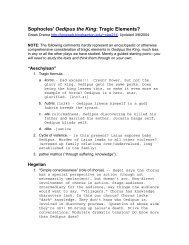Homework - Harvey.binghamton.edu
Homework - Harvey.binghamton.edu
Homework - Harvey.binghamton.edu
You also want an ePaper? Increase the reach of your titles
YUMPU automatically turns print PDFs into web optimized ePapers that Google loves.
ECONOMICS 360<br />
Spring 2007<br />
Written <strong>Homework</strong> Assignments with Due Dates<br />
1. TEXT: Page 10, Exercise 1.1<br />
2. TEXT: Page 25, Problem 9<br />
Professor S. W. Polachek<br />
HOMEWORK #1: 1/25/07<br />
3. Evidence Indicates that climate in an area influences labor supply. As an<br />
illustration assume the following labor supply function:<br />
Where<br />
Q L S<br />
= -200 + 200 W – 50 R<br />
Q L S = quantity of labor supplied,<br />
W = wage rate, and<br />
R = average rainfall per month.<br />
The demand for labor is given by<br />
Q D L = 1500 – 100 W<br />
Where<br />
W is as defined above and<br />
Q L D = quantity of labor demanded.<br />
a) What will be the employment level in Reigns, Rhode Island (a city<br />
with an average of 2 inches rainfall per month)<br />
b) Do wet areas (one with large amounts of rain) have higher or lower<br />
wages than dry areas: Explain using equations or graph.<br />
c) What would the unemployment rate in Reigns be if the minimum wage<br />
were $8 per hour<br />
4. TEXT: Page 49, Problem 7
HOMEWORK #2: 1/30/07<br />
1. TEXT: Page 86, Question for Review #2<br />
2. TEXT: Page 86, Problem 1<br />
3. TEXT: Page 87, Problem 5<br />
HOMEWORK #3: 2/1/07<br />
1. Erskine Erlemmeyer has the following utility function:<br />
Where<br />
U = 10 X 1 – X 1 2 + 20 X 2 – x 2<br />
2<br />
U = utility,<br />
X 1 = commodity one, and<br />
X 2 = commodity two.<br />
Fill in the following chart denoting the utility Erlemmeyer receives at various<br />
consumptions levels.<br />
Erlemmeyer’s Utility<br />
X 1<br />
X 2 0 1 2 3 4 5 6<br />
0<br />
1<br />
2<br />
3<br />
4<br />
5<br />
6<br />
7<br />
2. Prove that indifference curves cannot intersect each other.<br />
3. TEXT: Page 87, Problem 8 (a)<br />
HOMEWORK #4: 2/8/07<br />
I. TEXT: Page 87-88: Problems 14, 15 and 18<br />
II. Given the utility function of the last homework assignment
U = 10 X 1 – X 1<br />
2<br />
+ 20 X 2 – X 2<br />
2<br />
a) Compute the optimal consumption of X 1 and X 2 if the price of X 1 and<br />
X 2 are $1 each and Erskine Erlemmeyer has $6 to spend.<br />
b) Answer (a) if the price of X 2 rises to $2.<br />
Note that in this problem one can buy fractional units of X 1 and X 2.<br />
1. TEXT: Page 103: Problem 1.<br />
2. TEXT: Page 116 – Exercise 4.1<br />
3. Define: Engel Curve<br />
HOMEWORK #5: 2/13/07<br />
4. Given the utility function of the last homework assignment<br />
U = 10 X 1 – X 1 2 + 20 X 2 – X 2<br />
2<br />
a) Compute the optimal consumption of X 1 and X 2 if the price of X 1 and X 2 are<br />
$1 each and Erskine Erlemmeyer has $6 to spend.<br />
b) Answer (a) if Erskine Erlemmeyer now has $9 to spend.<br />
c) Are X 1 and X 2 normal, inferior, or luxury goods Justify.<br />
One can in this problem buy fractional units of X 1 abd X 2 .<br />
HOMEWORK #6: 2/15/07<br />
1. From Homwork Assignment #5 Do 4 (c )<br />
Given the utility function of the last homework assignment<br />
U = 10 X 1 – X 1 2 + 20 X 2 – X 2<br />
2<br />
Are X 1 and X 2 normal, inferior, or luxury goods Justify.<br />
2. TEXT: Page 142: Questions for Review 13, 14 and 15<br />
3. TEXT: Page 143: Problems 10 and 12.<br />
HOMEWORK #7: 2/20/07
1. TEXT: Pages 182-3: Problems 4 and 6.<br />
2. TEXT: Page 165: Exercise 5-3.<br />
HOMEWORK #8: 2/27/07<br />
1. TEXT: Page 309: Questions for Review 7 and 8.<br />
2. TEXT: 309: Problem 2.<br />
3. How is output measured in the evaluation of academic economists; performance<br />
in David Colander’s, “Research on the Economics Profession,” Journal of<br />
Economic Perspectives, Fall 1989, 137-149.<br />
1. TEXT: Page 309: Problem 4<br />
2. TEXT: Page 310: Problem 9<br />
3. TEXT: Page 310: Problem 10<br />
HOMEWORK #9: 3/1/07<br />
HOMEWORK #10: 3/6/07<br />
TEXT: Page 321 – Problem1 (Do only (a), (b), (d) and (e)<br />
HOMEWORK #11: 3/13/07<br />
TEXT: Page 352 – Problems 5, 6 and 7<br />
HOMEWORK #12: 3/20/07<br />
TEXT: Page 352 – Problems 1, 2 and 3<br />
1. Assume a firm has a cost function<br />
HOMEWORK #13: 3/22/07<br />
Where<br />
C = 8 + 2 Q + 0.1 Q 2<br />
C – represents total costs and<br />
Q – represents production output.<br />
a) What are the firm’s fixed costs.
) How much would the firm produce if it sells its output for $5 per unit<br />
c) How much would it produce if it sells its output for $2 per unit<br />
d) How much would it produce if it sells its output for $3 per unit<br />
e) Draw the firm’s supply curve.<br />
2. Page 402: Questions for Review 4 and 6.<br />
3. Page 402: Problems 2 and 3.<br />
1. Assume the following demand curve:<br />
Q D (t) = 100 – P(t)<br />
And the following supply curve:<br />
Q S (t) = 10 P (t-1)<br />
HOMEWORK #14: 3/27/07<br />
Make a table of the prices and quantities for five years if the initial price is<br />
assumed to be 7 dollars.<br />
2. There exists 10,000 firms in a market each with MC curve MC=2q<br />
Where<br />
Q = quantity of production (of the firm).<br />
Assume aggregate demand is 20,000 and independent of price.<br />
a) What is the market equilibrium and price<br />
b) What happens to the equilibrium price and quantity if one firm<br />
Drops out of the market for some exogenous reason<br />
3. Repeat Question #2 above if aggregate demand is: Q = 40000-5000P.<br />
TEXT: Page 449: Problem 1<br />
HOMEWORK #15: 4/10/07<br />
HOMEWORK #16: 4/12/07
1. All 10,000 firms in the last homework assignment were bought out by one<br />
company. How would pricing practices change Give a numeric answer.<br />
2. TEXT: Page 448: Question for Review #6.<br />
3. TEXT: Page 449: Problem 2.<br />
HOMEWORK #17: 4/17/07<br />
TEXT: Page 450: Problems 8 and 9.<br />
HOMEWORK #18: 4/19/07<br />
TEXT: Page 521, Exercise 14.8 and Page 541: Problem 7 (a)<br />
HOMEWORK #19: 4/26/07<br />
For Questions 1 to 5 below state whether true or false and briefly explain why:<br />
1. A Chamberlinian monopolistically competitive firm in long-run equilibrium will<br />
always produce on a downward-sloping portion of its long-run average cost curve.<br />
2. If a new firm enters a Chamberlinian industry with 30 incumbent firms and all,<br />
including the entrant, charge the same price, then all firms will set 1/31 of the<br />
total industry output.<br />
3. The existing firms in a Chamberlinian industry are currently earning economic<br />
profits at the short-run equilibrium price. The long-run equilibrium price will<br />
necessarily be lower than the current price.<br />
4. If there are economies of scale in the production of each model of automobile,<br />
then the poor would pay much less for their cars if we produced many fewer<br />
models than we do now.<br />
5. If a business owner is delighted to accept additional orders at the current price, he<br />
or she cannot have been a profit-maximizing, perfectly competitive producer.<br />
1. Page 499 – Problem #1<br />
2. Page 500 – Problem #8<br />
1. Page 609: Problem #1<br />
HOMEWORK #20: 5/1/07<br />
HOMEWORK #21: 5/8/07
2. Page 609: Problem #2<br />
HOMEWORK #22: 5/10/07<br />
Why is conflict smaller among trading partners



